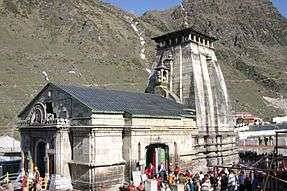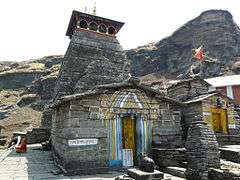Panch Kedar
| Panch Kedar | |
|---|---|
| Geography | |
| Coordinates | Kedarnath 30°43′48″N 79°4′12″E / 30.73000°N 79.07000°E, Tungnath 30°29′22″N 79°12′55″E / 30.48944°N 79.21528°E, Rudranath 30°32′0″N 79°20′0″E / 30.53333°N 79.33333°E, Madhyamaheshwar 30°38′13″N 79°12′58″E / 30.63694°N 79.21611°E and Kalpeshwar 30°34′37.35″N 79°25′22.49″E / 30.5770417°N 79.4229139°E |
| Country | India |
| State | Uttarakhand |
| Culture | |
| Primary deity | Shiva |
| Architecture | |
| Architectural styles | North Indian architecture |
| History and governance | |
| Date built | Unknown |
| Creator | Pandavas |
Panch Kedar (Sanskrit: पंचकेदार) refers to five Hindu temples or holy places of the Shaivite sect dedicated to god Shiva. They are located in the Garhwal Himalayan region in Uttarakhand, India. They are the subject of many legends that directly link their creation to Pandavas, the heroes of the Hindu epic Mahabharata.[1]
The five temples designated in the strict pecking order to be followed for pilgrimage for worship are the Kedarnath (Sanskrit: केदारनाथ) at an altitude of 3,583 m (11,755 ft), the Tungnath (तुंगनाथ)(3,680 m or 12,070 ft), Rudranath (रुद्रनाथ) (2,286 m or 7,500 ft), Madhyamaheshwar (मध्यमहेश्वर) or Madmaheshwar (3,490 m or 11,450 ft) and Kalpeshwar (कल्पेश्वर) (2,200 m or 7,200 ft). The Kedarnath is the main temple, which is part of the four famous Chota Char Dhams (literally 'the small four abodes/seats') or pilgrimage centers of the Garhwal Himalayas; the other three dhams are the Badrinath, Yamunotri and Gangotri. Kedarnath is also one of the twelve Jyotirlingas.[2][3]
The Garhwal region is also called the Kedar-Khanda after Kedar — the local name for Lord Shiva. The region abounds in emblems and aniconic forms of Shiva sect of Lord Shiva, much more than the Vaishnava sect. The western part of this region in particular, which constitutes half of Chamoli district being known as Kedar-Kshetra or Kedar mandala, encompasses in its ambit all the five temples constituting the Panch Kedar.[4]
Visitors to Kedarnath shrine, the first of the Panch Kedar temples for which records are available, was an impressive 557,923 in 2007 as against 87,629 in 1987, a quantum jump in 20 years.[5]
History
It is said that the Panch Kedar Yatra (pilgrimage) could be directly related to the Gorakhnath cult (recognized for their pilgrim traditions) of Nepal. As a proof, it is stated that the culmination of the pilgrimage was at Pashupatinath temple in Nepal, rightly where Lord Shiva’s head is worshipped and not at Kedarnath where the hump is venerated. A further supporting fact mentioned in this regard is that the emblem used in Kedarnath temple dome is the same as displayed in the Pashupathinath temple dome in Kathmandu.[6]
Legends
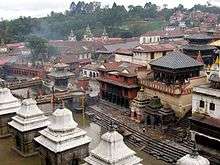

Many folk legends related to the Garhwal region, god Shiva and the creation of the Panch Kedar temples are narrated.
The most famous folk legend about Panch Kedar relates to the Pandavas, the heroes of the Hindu epic Mahabharata. The Pandavas defeated and killed their cousins — the Kauravas in the epic Kurukshetra war. They wished to atone for the sins of committing fratricide (gotra hatya) and Brāhmanahatya (killing of Brahmins — the priest class) during the war. Thus, they handed over the reigns of their kingdom to their kin and left in search of the god Shiva and to seek his blessings. First, they went to the holy city of Varanasi (Kashi), believed to Shiva's favourite city and famous for its Shiva temple. But, Shiva wanted to avoid them as he was deeply incensed by the death and dishonesty at the Kurukshetra war and was, therefore, insensitive to Pandavas' prayers. Therefore, he assumed the form of a bull (Nandi) and hid in the Garhwal region.
Not finding Shiva in Varanasi, the Pandavas went to Garhwal Himalayas. Bhima, the second of the five Pandava brothers, then standing astride two mountains started to look for Shiva. He saw a bull grazing near Guptakashi (“hidden Kashi” — the name derived from the hiding act of Shiva). Bhima immediately recognized the bull to be Shiva. Bhima caught hold of the bull by its tail and hind legs. But the bull-formed Shiva disappeared into the ground to later reappear in parts, with the hump raising in Kedarnath, the arms appearing in Tunganath, the nabhi (navel) and stomach surfacing in Madhyamaheshwar, the face showing up at Rudranath and the hair and the head appearing in Kalpeshwar. The Pandavas pleased with this reappearance in five different forms, built temples at the five places for venerating and worshipping Shiva. The Pandavas were thus freed from their sins. It is also believed that the fore portions of Shiva appeared at Pashupatinath, Kathmandu — the capital of Nepal.[2][7][8]
A variant of the tale credits Bhima of not only catching the bull, but also stopping it from disappearing. Consequently, the bull was torn asunder into five parts and appeared at five locations in the Kedar Khand of Garhwal region of the Himalayas.[7] After building the Panch Kedar temples, the Pandavas mediated at Kedarnath for salvation, performed yagna (fire sacrifice) and then through the heavenly path called the Mahapanth (also called Swargarohini), attained heaven or salvation.
After completing the pilgrimage of Lord Shiva's darshan at the Panch Kedar temples, it is an unwritten religious rite to visit Lord Vishnu at the Badrinath Temple, as a final affirmatory proof by the devotee that he has sought blessings of Lord Shiva.[9]
- Worship rights
The priests and pundits who worship in the Panch Kedar temples are from South India, except in Tungnath. Namboodiri brahmins hailing from Malabar, in Kerala officiate as chief priests at Badrinath temple and they are known by the name Rawals. Jangamas who are pure Lingayatisms from Chitrakal in Mysore are the chief priests at the Madhyamaheswar temple. Dasnami Gosains founded by Adi Shankaracharya are the chief priests in Rudranath and Kalpeshwar temples. The Tunganath temple is served by the Khasi Brahmins. In the case of Tungnath, it is also said that the local brahmins from Mokumath officiate as priests.
Kedarnath Teerth Purohit all Kedarnath Teerth Purohit (Panda) are the ancient brahmin of this himalaya region of Kedarkhand, these are there from the end of treta yug and start of kaliyug, when pandava came to himalaya for finding moksh, and then went to mahapanth, after their journey to mahapanth, their grandson King Janmejay came to Kedarnth and gave the right of worshiping of Kedarnath temple to these brahmins. These lives near Guptakashi. At the start the total no of these brahmins were 360 numbers.[10]
Geography

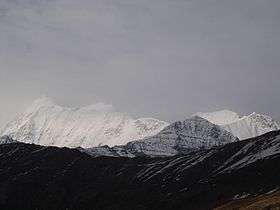
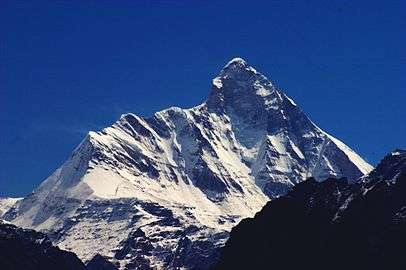
The five temples lie ensconced in the region of the Upper Himalayas with the high, snow-covered hill ranges of the Nanda Devi, Chaukhamba, Kedarnath and Neelkanth peaks forming their backdrop. Kedarnath is located in the Mandakini River valley while the other shrines are situated in the highlands between the Mandakini valley and the Alakananda gorge. They are so remotely located that except Rudranath, the other four are still not accessible by motorable roads but reached by strenuous trekking, starting from late April or early May till early October. For the rest of year (the winter season), the shrines are closed due to heavy snowfall. Rudranath is accessible throughout the year by a short trek of about 3 km (2 mi) from the nearest road head. (See External links for schematic maps of the locations of Panch Kedar).[2]
The village of Kedarnath is on the edge of Kedarnath mountain slope in a remote northern part of the Garhwal Himalayas. Kedarnath ranges drain into the Mandakini River that emerges from the steady edge of the Churabre glacier and forms the picturesque Mandakini valley. The Dudhganga, Madhuganga, Swargaduari and Saraswathi are the streams that flow in the valley behind the Kedarnath temple. Also seen close to the temple are four sacred ponds called Retah, Udak, Rudra and Rishi.[2] Tunganath has an impressive backdrop of the peaks of Panchulli, Nanda Devi, Dunagiri, Kedarnath and Bandar Poonch. The Vaitarani stream flows near Rudranath.[8] Kalpeshwar is located in the Urgam valley in a dense forest area. Urgam Valley has apple orchards, terraced fields where potato is grown extensively. Kalp Ganga river, a tributary of the Alaknanda, flows through the valley.[11]
Access by trekking
The Panch Kedar temples are accessible by only from the nearest road heads but in different directions, lengths and scale of difficulty (ruggedness, steepness and snow cover). The trek routes located in the Garhwal region provide a dazzling and enchanting display of the high snow peaks of Nanda Devi (7,817 m or 25,646 ft), Trishul (7,120 m or 23,360 ft) and Chaukhamba (7,138 m or 23,419 ft). Garhwal region is where the most worshipped Ganga River and its many tributaries originate adding to the reverence of the Panch Kedar temples.[11]
The total trek length to cover all the five temples of Panch Kedar is about 170 km (110 mi) (including road travel up to Gaurikund), involving 16 days of strenuous and rewarding effort. The trek starts from Gauri Kund, one of the picturesque spots, providing spectacular views of the Himalayan range of hills in the entire Garhwal region, comparable to the Alps.[11] The trekking is undertaken during two seasons; three months during summer and two months after the monsoon season, as during the rest of the period, except Rudranath, the other four Panch Kedar temples are inaccessible due to snow cover.[7]
The road from Rishikesh is the first entry point to Garhwal from the plains of Uttarakhand. Rishikesh is approachable from Delhi by road over a distance of 230 km (140 mi). The road from Rishikesh leads to the Gaurikhund on the Rudraprayag–Kedarnath road from where the trekking would start to Kedarnath temple. The trek to Kedarnath is of 14 km (8.7 mi), each way. After Kedarnath, road travel to Guptakashi and further to Jagasu covers a distance of 30 km (19 mi). From Jagasu, the trek to Madhaymaheshwar temple via Gaundhar is over a distance of24 km (15 mi). This trek provides spectacular views of the Chaukhamba, the Kedarnath and the Neelkanth peaks. Returning from Madhyamaheshwar the road drive to Chopta via Jagasu is of 45 km (28 mi). From Chopta, the trek is to the Tunganath temple over a distance of about 4 km (2.5 mi). After the Tunganath trek, the drive along the road up to Mandal (known Cherrapunji of Garhwal due to heavy rainfall) is for a distance of8 km (5.0 mi). From Mandal, the trek to Rudranath temple is of 20 km (12 mi). After visiting Rudranath temple the return journey is to Mandal and the drive down by road to Helang. From Helang, the trek to Kalpeshwar temple is for 11 km (6.8 mi) via Urgam village and is considered strenuous due to the steepness of the route. After completing the pilgrimage trek of Kalpeswar temple, the last of the Panch Kedar temples, the return road drive from Helong to Riishikesh via Pipalkothi is a distance of 233 km (145 mi).[11][12]
Wetrekkers is the best for this kind of trek.The nearest airport is Jolly Grant, Dehradun (258 km or 160 mi). The nearest railway station is Rishikesh (241 km or 150 mi).[13]
Worship during winter season
During the winter period when the temples are inaccessible due to snowfall, the sanctified symbolic Shiva idol of Kedarnath is worshipped at the Omkareshwar temple at Ukhimath, the representational idol of Tunganath is worshipped at Mokumath, the Rudranath symbolic image is brought to Gopeshwar, and the Madhyamaheshwar symbolic idol is venerated at Ukhimath.[2][7]
References
- ↑ "Eight days of bliss". Retrieved 2009-07-05.
- 1 2 3 4 5 Harshwanti Bisht (1994). Tourism in Garhwal Himalaya. Panch Kedar. Indus Publishing. pp. 84–86. ISBN 9788173870064. Retrieved 2009-07-05.
- ↑ "Chard Dham Yatra". Government of Uttarakhand, Official website. Retrieved 2009-07-14.
- ↑ J. C. Aggarwal; Shanti Swarup Gupta (1995). Uttarakhand: past, present, and future. Chamoli district. Concept Publishing Company. p. 222. ISBN 9788170225720.
- ↑ "Number Of Pilgrims". Retrieved 2009-07-20.
- ↑ Bill Aitken (2003). Footloose in the Himalaya. Chapter 15: The Best Little Trek. Orient Blackswan,. pp. 134–141. ISBN 9788178240527. Retrieved 2009-07-15.
- 1 2 3 4 "Panch Kedar Yatra". Retrieved 2009-07-05.
- 1 2 Kapoor. A. K.; Satwanti Kapoor. Ecology and man in the Himalayas. M.D. Publications Pvt. Ltd. p. 250. ISBN 9788185880167.
- ↑ "Panch Kedar". Retrieved 2009-07-15.
- ↑ Jha, Makhan (1998). India and Nepal. Sacred Complex in Garhwal Himalayas. M.D. Publications Pvt. Ltd. p. 143. ISBN 9788175330818.
- 1 2 3 4 "Trekking in India". Retrieved 2009-07-12.
- ↑ Bradnock, Roma (2000). Indian Himalaya handbook. Footprint Travel Guides. pp. 114–5.
- ↑ "Panch Kedar: Rudranath". Shri Badrinath -Shri Kedarnath Temple Committee. 2006. Retrieved 2009-07-16.
